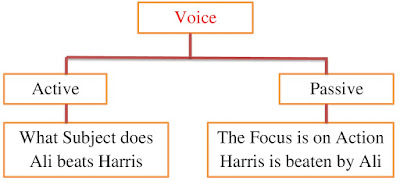Lesson for Voice Change / Active Voice & Passive Voice Process Subject English Grade 9th
Lesson for Voice Change / Active Voice
& Passive Voice Process
Subject English
Grade 9th
Students` Leaning Outcomes
- By the end of this lesson, Students will be able to know about the voice / describing a process.
Information for
Teachers
- [Special stress has been given on the Passive mode to describe something in real-life situation, not wishing to specify the agent (e.g. the house was built in 2015 including Quasi-Passive Voice (e.g. the room looks nice.)]
- Just Transitive Verbs can be changed as passive voice because in such types of verbs can take an object. These verbs indicate whether the subject is acting or being acted upon. When the subject is doing the action, the sentence is said to be in the Active Voice. Whenever the subject is acted upon, then the sentence is count to be in the Passive Voice.
What is the meaning of
‘Voice’?
- The tern ‘Voice’ is the form of the verb which shows whether the Subject is doer of the action or something has been done by it.
- There are three kinds of Voices:
- Active Voice
- Passive voice
- Quasi-Voice
- Active Voice: When the
subject of a sentence is the doer or actor, the verb Active Voice. It is so
because the subject is active. A verb is said to be in the Active Voice when
the subject acts or performs the action; as,
- Harris killed a snake.
- Rafi sings a song.
- Shan is writing a letter.
- I do this work.
- He does this work.
- He did this work, etc.
- In these sentences, the objects ‘a snake’, ‘a song’, ‘a letter’,’ this work, etc. are placed after the verbs ‘killed’, ‘sings’, ‘is writing’ and ‘do,, does, did. The aforesaid subjects ‘Harris, Rafi, Shan, and I, have been placed before the verbs to show that the action is performed by the Subjects. All the aforesaid sentences are count as Active Voice.
- Passive Voice: When the
subject of a sentence is acted upon, then the sentence will be count in Passive
Voice. It is so because the subject is passive. A verb is said to be in the
Passive Voice, when the subject of the verb is acted upon or receives the
action, as;
- A snake was killed by Harris.
- A song is sung by Rafi.
- A letter is being written by Shan.
- This work is done by me.
- This work was done by him.
- In these sentences, the subjects ‘a snake’, ‘a song’, ‘a letter, ‘this work’, receives the action done by the objects ‘Harris’, ‘Rafi’, ‘Shan’, and ‘I’, so the verbs: was killed, is sung, is being written, was done, are in Passive Voice.
Active Passive Relation:
Five Basic Changes in
Voice:
- Rule 1: When a verb is changed from the Active into the Passive Voice, the Subject is replaced with Object and Object with Subject. Note: Pronouns are changed as under:
|
Subject |
|
Object |
||
|
I We You He She It They |
is is is is is is is |
changed
changed changed changed changed changed changed |
into
into into into into into into |
me us you him her it them |
|
|
|
|
|
|
- Rule 2: Only third form of verb is used in Passive Voice.
- Rule 3: Use the helping verb according to the tense before third form of verb.
- Rule 4: When subject is placed at the position of object. Its objective case is used. It is then called a agent. Such indefinite and vague subjects as ‘someone’, ‘somebody’, ‘everyone’, ‘everybody’, ‘they’, ‘people’, etc. are dropped.
- Rule 5: ‘By’ is used with the agent when it helps to complete the sense.
Verb Shapes of Passive
Voice
Table of Tenses in
Active and Passive:
|
Tenses |
Active Voice |
Passive Voice |
|
Simple Present |
buys |
Is / are bought. |
|
Simple Past |
bought |
Was / were bought. |
|
Present Continuous |
is / are buying |
Is / are being bought. |
|
Past Continuous |
was / were buying |
Was / were being bought. |
|
Present Perfect |
has / have bought |
Has / have been bought. |
|
Past Perfect |
had bought |
Had been bought. |
|
Simple Future |
shall / will buy |
Will be bought. |
|
Conditional |
would buy |
would be bought |
|
Perfect Conditional |
would have bought |
Would have been bought. |






Comments
Post a Comment